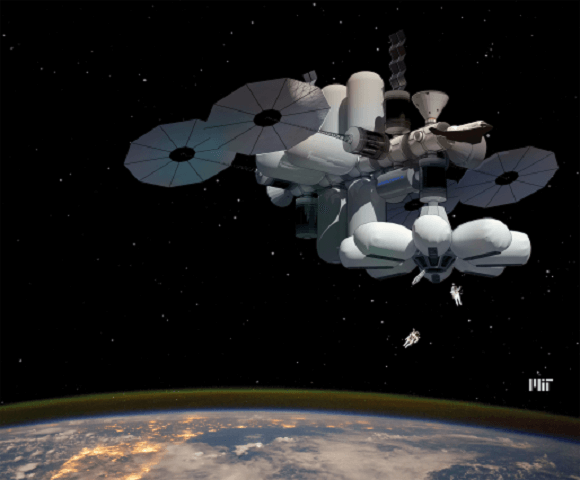Looking to the future of space exploration, there really is no question that it will involve a growing human presence in Low Earth Orbit (LEO). This will include not only successors to the
International Space Station
, but most likely commercial habitats and facilities. These will not only allow for ventures like space tourism, but will also facilitate missions that take us back to the Moon, to Mars, and even beyond.
With this purpose in mind, an interdisciplinary team of MIT graduate students designed a space habitat known as the
Managed, Reconfigurable, In-space Nodal Assembly
(MARINA). This module would serve as an privately-owned space station that would be occupied by two anchor-tenants for a period of ten years; a luxury hotel that would provide orbital accommodations, and NASA.
For their invention, the team won first prize in the graduate division of the
Revolutionary Aerospace Systems Concepts-Academic Linkage Design Competition Forum
(RASC-AL), a yearlong graduate-level competition hosted by NASA. This challenge involved designing a commercial module for use in low Earth orbit that could also serve as a Mars transit vehicle in the future.
[caption id="attachment_128354" align="aligncenter" width="580"]
In the future, LEO will become home to commercial modules (like the Bigelow Aerospace B330 expandable module, shown here), will become a reality. Credit: Bigelow Aerospace
[/caption]
Since 2002, RASC-AL competitions have sought to engage university students and advisors for the purpose of coming up with ideas that could enhancing future NASA missions. For this year's competition, NASA asked teams to develop human spaceflight concepts that focused on operations in cislunar space - i.e. in, around, and beyond the Moon - that could also facilitate their proposed "
Journey to Mars
" by the 2030s.
Specifically, they were tasked with finding ways to leverage innovations and new technologies to improve humanity's ability to work more effectively in microgravity. With this in mind, the
themes for this year's competition
ranged from from the design of more efficient subsystems to the development of architectures that support NASA's goal of extending humanity's reach into space.
These included new designs for a Lightweight Exercise Suite, Airlock Design, concepts for a C
ommercially Enabled LEO/Mars Habitable Module, and concepts for a new Logistics Delivery System.
As Pat Troutman, the Human Exploration Strategic Analysis lead at NASA's Langley Research Center, said in a NASA press statement:
[caption id="attachment_136321" align="aligncenter" width="580"]
Members of the MIT team (from left to right): Caitlin Mueller (faculty advisor), Matthew Moraguez, George Lordos, and Valentina Sumini. Credit: MIT/MARINA team
[/caption]
Led by Matthew Moraguez, a graduate student at MIT's
Department of Aeronautics and Astronautics
(AeroAstro) and a member of the
Strategic Engineering Research Group
(SERG), the MIT team focused on the theme of creating a C
ommercially Enabled LEO
Habitat Module. Their concept, which incorporates lessons that have been learned from the ISS, was designed with the needs of both the private and public space sectors in mind.
As George Lordos - a graduate fellow in the MIT
System Design and Management (SDM) Program
, and a team member of both MARINA and SERG - explained:
To meet their goals for the competition , the team came up with a modular design for MARINA that featured several key innovations. These included extensions to the
International Docking System Standard
(IDSS) interface (used aboard the ISS), modular architecture, and a distribution of subsystem functions throughout these modules. As Moraguez explained, their design will allow for some wide-ranging opportunities.
"Modularized service racks connect any point on MARINA to any other point via the extended IDSS interface," he said. "This enables companies of all sizes to provide products and services in space to other companies, based on terms determined by the open market. Together these decisions provide scalability, reliability, and efficient technology development benefits to MARINA and NASA."
Another important benefit comes in the form of cost-savings. According to NASA estimates, the recurring cost of MARINA will be about $360 million per year, which represents a significant reduction over the current costs of maintaining and operating the ISS. In total, it would offer NASA a savings of about $3 billion per year, which is approximately 16% of the agency's annual budget.
But what is perhaps most interesting about the MARINA concept is the fact that it could serve as the world's first space hotel. According to Valentina Suminia, a postdoc at MIT who contributed to the architectural concept, the space hotel will be "a luxury Earth-facing eight-room space hotel complete with bar, restaurant, and gym, will make orbital space holidays a reality."
Other commercial features include serviced berths that would be rented out to accommodate customer-owned modules. This goes for the station's interior modularized rack space as well, where smaller companies that provide contract services to on-board occupants would be able to rent out space. Would it be too much to ask that it also has robot butlers?
The RASCAL competition began in August of 2016 in Cocoa Beach, Florida, and concluded on June 2nd, 2017. The top overall honors were awarded to the teams from Virginia Tech and the University of Maryland for their space habitat concepts, known as
Project Theseus
and
Ultima Thule
, respectively.
Further Reading: MIT
,
 Universe Today
Universe Today
